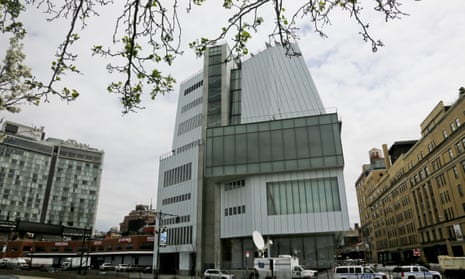Seven artists have removed their work from the 2019 Whitney Biennial, citing the New York museum’s lack of response to calls for the resignation of a board member with ties to trade in law enforcement supplies.
The removals from the prestigious survey of American art come after 46 of 75 artists picked for the show signed a letter in March demanding the resignation of Warren Kanders, a vice-president of the Whitney board with ties to a company that distributes equipment including teargas that the letter said has been used on migrants at the Mexican border, Palestinians in Gaza, protesters in Egypt and Puerto Rico, and against Native Americans protesting a pipeline at Standing Rock.
Many still exhibited but the protest was joined by more than 100 artists including Barbara Kruger and Nan Goldin, as well as dozens of curators, critics and theorists.
In a letter to the Whitney curators, the six artists who removed their work on Friday and Saturday (another cancelled his involvement before the show opened) said they were angered and conflicted by Kanders’ connections to Safariland, a distribution company.
Eddie Arroyo, Agustina Woodgate, Korakrit Arunanondchai, Meriem Bennani, Nicole Eisenman, Nicholas Galanin and Christine Sun Kim said the Whitney board’s failure to meaningfully respond to the March letter had forced their hand.
“Growing pressure from artists and activists has made our participation untenable,” read their letter, which was obtained by ArtForum. “The museum’s inertia has turned the screw, and we refuse further complicity with Kanders and his technologies of violence.”
Also on Saturday, the London-based collective Forensic Architecture requested that a 10-minute video called “Triple-Chaser”, made with Praxis Films, which is run by the film-maker Laura Poitras, be taken down. Forensic Architecture said one of its researchers found what they believe to be direct evidence linking the firm to violence classified by the United Nations in a recent report as a potential war crime.
After the requests to withdraw the works were made public, museum director Adam Weinberg said in a statement: “The Whitney respects the opinions of all the artists it exhibits and stands by their right to express themselves freely.”
The museum was “saddened” he said, adding “we will of course comply with the artists’ request”.
Art institutions are increasingly exposed over the sources of their funding. In June, Yana Peel, the chief executive of the Serpentine Galleries in London, stepped down after she was linked in a Guardian report to the Israeli cybersecurity firm NSO, which has been criticised by human rights organisations.
Protests organised by Goldin at the Metropolitan and Guggenheim museums in New York, and regarding the Tate in London and the Louvre in Paris, with the anti-opioid group Pain, have forced several institutions to refuse funding from the Sackler family, whose firm, Purdue Pharma, has been accused of a role in triggering the opioid-abuse crisis. In March, some Sackler philanthropic groups said they would suspend giving.
Michael Quinn, a lawyer who works with Goldin and Pain, told the Guardian artists were merely stepping into a vacuum “created by government and corporate leaders’ failure to address some very basic societal problems”.
“I see artists increasingly stepping in as the voice of change,” he said. “This is clear from in the political work being exhibited.”
The signatories of the March Whitney letter said “the stakes of the demand to remove Kanders are high and extend far beyond the art world.
“Cultural institutions like the Whitney are among the few spaces in public life today that claim to be devoted to ideals of education, creativity and dissent beyond the dictates of the market. Yet these institutions have been historically entwined with the power structures of settler colonialism, white supremacy, heteropatriarchy and capitalism.”
The art world, the Washington Post said recently, is full of “good places to convert roughly obtained private wealth into social prestige”. But it is being roiled by identity politics. To many artists, this is both heroic and antagonizing.
“The art world’s anti-corporatism can seem hypocritical,” said the New York artist and critic Walter Robinson. “But don’t forget art is a luxury business supported by billionaires and the avant garde art is [a] product of the 1%.”
Robinson said museums and institutions anxious about their endowments would be better off considering such money as fines to be paid. But that, he conceded, is unlikely.
“Identity is now an essential element in art – and identity is political,” he said. “Art used to gain its power from aesthetic invention but it now seeks relevance by aligning itself with progressive politics.”
The artist Marilyn Minter, long rumored to be a member of Guerrilla Girls, a feminist activist group that has protested gender and ethnic bias in culture since the 1980s, said: “Nan Goldin is my hero.”
“I fucking hate the art world,” she added.
